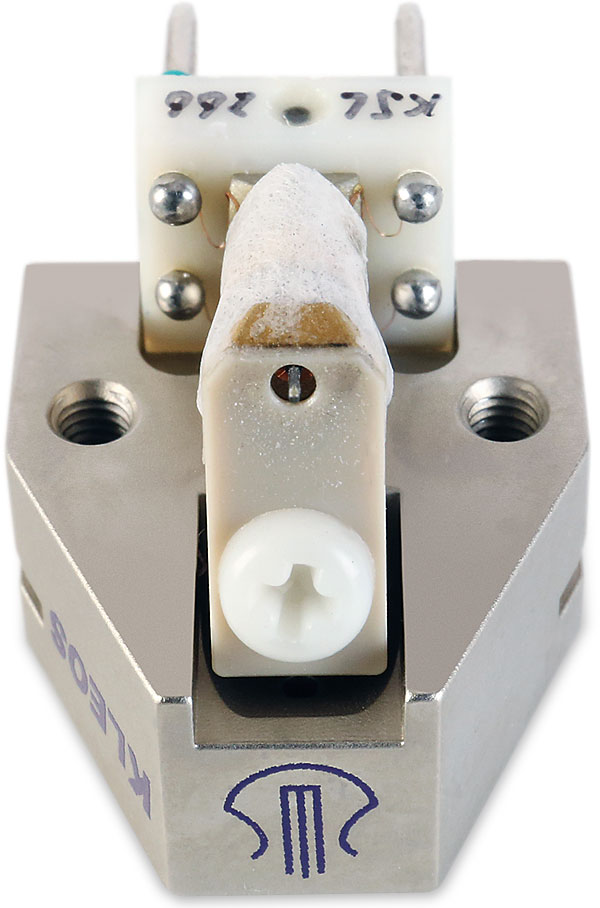Lyra Kleos SL Cartridge

 Coinciding with the 40th anniversary of the company's founding, Lyra introduces a refinement to the popular Kleos moving-coil cartridge – the SL with, yes, lower output
Coinciding with the 40th anniversary of the company's founding, Lyra introduces a refinement to the popular Kleos moving-coil cartridge – the SL with, yes, lower output
Has it really been 40 years since Jonathan Carr and Stig Bjørge founded what would become Lyra? Did I really play with a (Scan Tech) Tsurugi, launched in 1986 and which I still have, when Maggie was PM? As I have enjoyed Lyra cartridges for over half my life, including many happy hours with the mono Kleos, the £3095 Kleos SL arrived with positive anticipation.
Having recently achieved the refurbishment of the aforementioned Tsurugi, I was struck by the clarity of purpose which Lyra has maintained over the decades, not least the removal of the cartridge body. On the Tsurugi, two screws released it. For its Lyra MCs, they've done away with it altogether. I've heard conflicting arguments for and against what Lyra calls a cartridge played 'in the nude', some types needing the shielding, others not so much, but I do recall preferring the Tsurugi sans bodyshell and, likewise, all the current Lyras remain shell-free.
Righteous Path
Carr's core philosophy concerns 'a direct energy path from diamond, cantilever, coils through the solid metal body and into the tonearm'. Part of this includes avoiding the typical practice 'of most other cartridges' that have plastic elements inbetween, thus breaking this 'energy path'.
The Kleos MC was launched in 2010, one up from the bottom of a catalogue which includes the less costly Delos models, and below the dearer Etna and Atlas lines. It followed the launch of the Delos [HFN May '13] in 2008, which was the first 'New Angle' cartridge for which Carr re-thought how the coil needed to be positioned during playback. This led Carr to revise the angles of the entire body structure to achieve a more ideal playback situation. In practice the suspension is arranged so that the coils are optimally positioned within the (fixed) magnetic field once the correct tracking force is applied. This might seem an obvious requirement, but not all cartridge designs are so well thought out…

Historians among you will note, then, that the Kleos follows the lineage of Tsurugi/Clavis/Clavis DC/Helikon, thus maintaining the middle ground status of the range. The Kleos replaced the Delos' more cost-effective Namiki boron cantilever and microridge stylus with the more advanced Ogura solid boron cantilever and diamond found in the dearer Lyra models. The stylus is a custom 3x70μm line-contact type, which Lyra developed in collaboration with Ogura some 20 years ago, and which it continues to use in all its upper range models.
The Kleos is also the manufacturer's least costly model with press-fit rods within the cartridge body for better control of resonances. It also features a stronger chassis machined from aircraft-grade alloy, the hardest grade 7075 aluminium. The cartridge's front piece is a non-metal, non-conductive material just as the mounting bolt is a rigid polymer.
Made to order and with a 10% uplift in price over the standard Kleos, the Kleos SL (Single Layer) has a lower internal impedance, less output, and, says the company, 'possibly more purity, if the user has the right phono stage that is able to bring out its qualities'. Another physical detail is colour-coded, platinum-plated contact pins for easy, secure connection.
Although the Kleos SL is a doddle to set up because of the exposed cantilever and spot-on tracking at 1.75g, its output will be the cause of some head-scratching. As with every trade-off in audio, the move to lower output for a 'more pure and pristine sound' requires a phono stage with sufficient gain and low noise.
Pick-Up Pick 'N' Mix
Now I'm not suggesting that this cartridge will mate perfectly with a fixed-gain, budget-priced phono stage that expects to be paired with high-output moving-coils. I tried it with three such models, and in every case, I had to turn up the Audio Research REF 6SE [HFN Jan '21] preamp's gain higher than I would for, as examples, Koetsu, Denon, Ortofon, or TechDAS MCs. The surprise came when the Kleos SL gave fine results with a £625 Pro-Ject Tube Box DS2 [HFN Jul '20] at its maximum gain setting of 65dB, and an EAT E-Glo Petit [HFN Feb '19] with 70dB gain.


















































